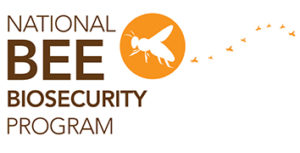Swarms and How to Treat them for Varroa Mites.
22 October 2024Article By: Rod Bourke, Bee Biosecurity Officer NSW Department of Primary Industries and Regional Development As spring arrives most areas have been seeing swarming bees. Some of the earliest […]

Article By: Rod Bourke, Bee Biosecurity Officer NSW Department of Primary Industries and Regional Development
As spring arrives most areas have been seeing swarming bees. Some of the earliest locations to get swarming were the old red zone areas from Sydney up to Kempsey, which are also highly infested with varroa mites. It’s safe to assume that nearly every swarm caught in those areas will already have a lot of mites on them, but don’t worry about that affecting their value to you.
No matter where you are within NSW (and probably the rest of Australia as mites steadily move across it), best practice is that once the captured colony has settled (perhaps after 1-4 days in the box), do varroa monitoring (alcohol wash, soapy water wash or sugar shake) to determine what, if any mite loading is on those bees. Please note that high humidity, rain, a nectar flow or newly swarmed bees that are full of honey (which may purge during the extreme stress of a sugar shaking event) can drastically reduce the accuracy of a sugar shake, so an alcohol wash or soapy water wash is generally a more accurate method of determining mites.
Once you have washed your bees you can determine what may need to be done to them with regards to managing any varroa mites they have.
It is always best practice to take young nurse bees from the brood area when doing mite monitoring (not forager bees nor bees from the honey box), so if the colony has not yet started laying eggs when you do check then look for a central frame within the box. Alternatively look for the frame with the queen calmly working on it (unless you had already smoked or driven her off a good frame to an outside frame, which may not be the best one to sample), remove her safely onto another frame and then shake off some of those remaining bees to sample. It should always be ½ cup (approximately 300 bees) for a good sample, as sampling less bees than that is less accurate.
Because newly collected swarms can sometimes be flighty and temperamental it is always good to ensure that they have fully decided to stay before undertaking this somewhat disturbing procedure of shaking bees off a frame, so if you prefer to wait a little bit longer until they are laying eggs nicely then that’s fine. But, don’t wait too long until they have advanced larvae before doing your mite sampling, as varroa may have already moved off the bees and into these brood cells. That would make it harder to find them when you do sample and therefore give you an incorrect (lower than actual) mite reading.
Outside of the normal swarming season, but also during it there will be colonies that are actually absconding (instead of half the colony swarming) from their original location. Absconding is a way that bees escape a dire situation and try to reduce the concentration of damaging pests (such as varroa mite or small hive beetle) or diseases (especially American foulbrood) that had caused significant health issues in their previous colony location. These absconding colonies sometimes have quite high mite loads, and the number of bees in it can be quite small in size if their numbers had been dwindling in their previous impacted colony. Absconding colonies are not always as healthy as a swarm may be, so keep a close eye on them as they may fail to expand well and again suffer their previous issues, but in your boxes now.
Brood-less colonies (new swarms, absconding colonies or packages from a supplier) are very easily treated for varroa, as all the mites are fully exposed and vulnerable on the adult bees until the colony has reared its own advanced well-fed larvae that are about to be capped (this often happens from around day 8-9 after the swarm is captured). Unless the swarm looks extremely unhealthy then you should not consider euthanising them. Instead, you can add some synthetic flumethrin (Bayvarol is currently the only flumethrin product legally available in Australia) miticide strips and watch those mites fall off and the bee colony turn into a beautiful hive of bees.
The reasons we suggest using Bayvarol strips in this situation instead of other synthetic strips or organics are:
1. Bayvarol will provide the colony with 6-8 weeks of protection from reinfestation (field bees bringing new mites back into the hive), which is likely high if your swarm and the apiary area already has varroa present. Check the Heatmap for updated information on reported mites in your area – www.dpi.nsw.gov.au/varroa
2. Bayvarol can be used when bees are producing honey, which most strong swarm colonies will quickly produce in that first 8 weeks after their arrival. The other synthetic products cannot be used when honey is being produced, so they would only be used instead of Bayvarol if you captured a small swarm that will take 6+ weeks to expand and fill the brood box.
3. The organics may repel a caught swarm before it is fully established, causing its loss.




The New South Wales (NSW) Department of Primary Industries and Regional Development delivers the NSW component of the National Bee Biosecurity Program (NBBP), and provides significant co-investment and expertise. The NBBP is coordinated by Plant Health Australia and funded by the Australian Honey Bee Levy.
